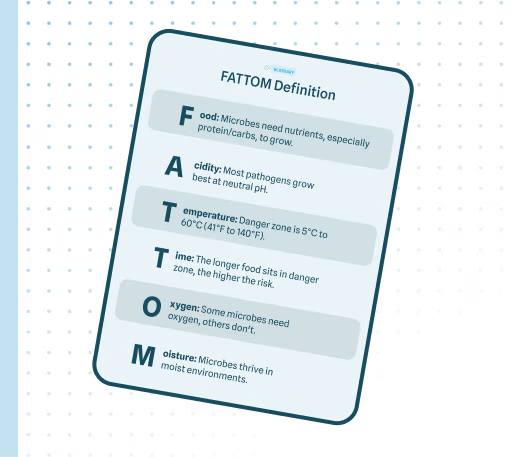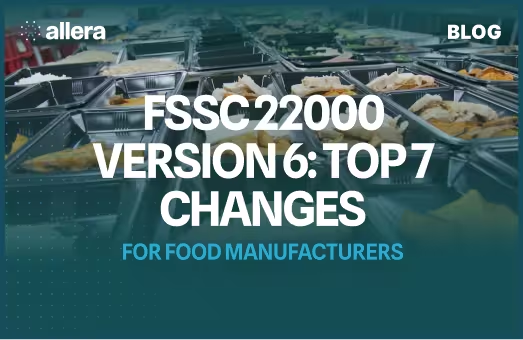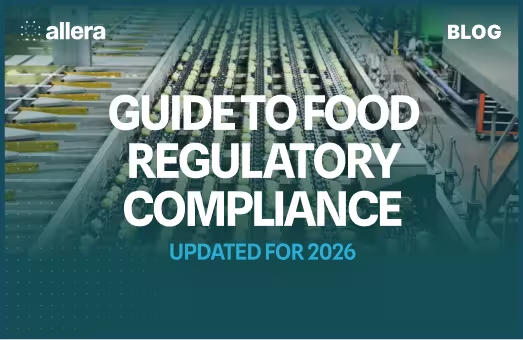

FATTOM? Definition, Meaning, & Secrets: Practical Guide


Key Takeaways:
- FATTOM outlines six factors—Food, Acidity, Time, Temperature, Oxygen, and Moisture—that determine how bacteria grow in food.
- Managing time and temperature is the most effective way to prevent bacterial growth and keep products safe.
- Acidity and moisture control help extend shelf life and reduce the risk of foodborne illness.
- FATTOM principles are the foundation of major food safety programs like HACCP, SQF, and BRCGS.
- Digital monitoring and documentation tools make it easier to maintain consistent FATTOM control across production.
Introduction to FATTOM in Food Safety
Have you ever wondered why some foods spoil faster than others? Or why your production facility needs such strict temperature controls? The answer lies in a simple yet powerful acronym that every food manufacturer should know by heart: FATTOM.
FATTOM represents the six critical factors that influence bacterial growth in food products. For food manufacturers across America, understanding this concept isn't just about passing audits—it's about protecting consumers and building a reputation for food safety and quality assurance (FSQA). Whether you're producing ready-to-eat meals, dairy products, or preserved goods, FATTOM provides the framework for controlling microbial hazards at every stage of production.
In this comprehensive guide, we'll break down what FATTOM means, why it matters, and how you can implement these principles to meet regulatory standards while keeping your products safe.
.avif)
Breaking Down the FATTOM Acronym
FATTOM is a classic food safety acronym describing the six major factors that affect the growth of foodborne pathogens: Food, Acidity, Time, Temperature, Oxygen, and Moisture. Think of it as the recipe that bacteria need to thrive—and your job as a food manufacturer is to disrupt that recipe at every possible point.
F – Food (Nutrient Content)
Bacteria, like all living organisms, need fuel to grow. The "F" in FATTOM stands for food—specifically, the nutrient content that pathogens require to multiply.
Pathogenic bacteria flourish in foods that are high in protein and moisture. We're talking about meats, poultry, seafood, dairy products, cooked rice, beans, and cut fruits. These foods provide the perfect buffet of nutrients that bacteria need to thrive.
According to the FDA's "Evaluation and Definition of Potentially Hazardous Foods," these foods are classified as Time/Temperature Control for Safety (TCS) foods. This designation means they must be properly managed to inhibit pathogen growth. If you're manufacturing products with high protein content or rich nutrient profiles, you're working with ingredients that bacteria absolutely love.
What can you do about it? You can't change the nutrient content of your products—after all, consumers want nutritious food. But you can control the other factors in FATTOM to prevent bacterial growth despite the favorable nutrient environment.
A – Acidity (pH Levels)
The "A" in FATTOM stands for acidity, measured by pH levels. Most bacteria responsible for foodborne illness prefer a pH range above 4.6—they like their environment relatively neutral, much like we do.
Here's where acidity becomes your ally: foods with a pH below 4.6 are less likely to support growth of dangerous pathogens like Salmonella or the botulinum toxin according to federal standards. This is why pickles, sauerkraut, and other fermented foods have such impressive shelf stability—their acidity creates an environment where harmful bacteria simply can't thrive.
For food manufacturers, understanding pH is crucial. If you're producing acidified foods, you need to ensure consistent pH levels throughout your batches. A variation of even 0.2 pH units can mean the difference between a safe product and a potential hazard.
Are you monitoring pH at critical control points? Do you have documented procedures for acidification? These aren't just good practices—they're often regulatory requirements for certain product categories.
T – Time
Time is a critical factor that often gets overlooked in busy production environments. The first "T" in FATTOM represents how long food remains in conditions favorable for bacterial growth.
Here's a sobering fact: the FDA indicates that pathogenic bacteria can double every 20 minutes under optimal conditions. Let that sink in for a moment. In just two hours, one bacterial cell can become over 4,000 cells. After four hours in the danger zone, that number explodes into the millions.
This is why time management is so crucial in food manufacturing. Every minute your product spends at unsafe temperatures is an opportunity for bacteria to multiply exponentially. Your receiving procedures, processing times, cooling protocols, and holding periods all need to be tightly controlled and documented.
Many facilities implement time stamps, production scheduling software, and clear procedures for how long products can remain at various stages before they must be moved, refrigerated, or discarded.
T – Temperature
The second "T" in FATTOM stands for temperature—arguably the most critical control factor for most food manufacturers.
The USDA defines the "Danger Zone" as 40°F–140°F (4°C–60°C). Within this temperature range, bacteria can grow rapidly. Keeping TCS foods outside this range is a core control in HACCP, BRCGS, SQF, and other GFSI-benchmarked standards.
Temperature control isn't just about your refrigerators and freezers. It encompasses every point in your process where food could enter the danger zone: receiving docks in summer heat, production lines, cooling procedures after cooking, hot holding equipment, and transportation.
What makes temperature control challenging is that it requires constant vigilance. Your cooling equipment can fail, power outages happen, and human error is always a possibility. This is why robust temperature monitoring systems—complete with alarms, backup power, and documented corrective actions—are essential for any food manufacturing operation.
O – Oxygen
The "O" in FATTOM represents oxygen, and this factor is more nuanced than you might think.
Some bacteria are aerobic—they need oxygen to survive. Others are anaerobic—they thrive in oxygen-free environments. And some, called facultative anaerobes, can adapt to either condition. Controlling oxygen through modified atmosphere packaging or vacuum sealing permits management of both aerobic and anaerobic bacteria, including Clostridium botulinum, which is a HACCP critical control point in many ready-to-eat foods.
For food manufacturers, oxygen control opens up opportunities for extended shelf life through technologies like vacuum packaging, nitrogen flushing, and controlled atmosphere storage. However, these technologies also require careful management. For example, vacuum-packed foods can create the perfect anaerobic environment for C. botulinum if temperature controls fail.
Understanding which pathogens you're most likely to encounter in your products and how they respond to oxygen is essential for designing effective control strategies.
M – Moisture (Water Activity)
The final letter in FATTOM stands for moisture, specifically measured as water activity (aw).
Water activity isn't the same as moisture content. It measures the available water that bacteria can actually use for growth. The FDA designate foods with water activity (aw) above 0.85 as high-risk; below this threshold, most pathogens cannot multiply. This principle is codified in the Food Code and referenced in SQF and BRCGS audits.
Think about dried foods, jams with high sugar content, or cured meats—these products have moisture, but much of that water is bound up and unavailable to bacteria. This is why they can be stored safely at room temperature.
For manufacturers, controlling water activity can be achieved through drying, adding salt or sugar, or adjusting formulations. However, it requires precise measurement and consistent processing to ensure every batch meets safety specifications.
Why FATTOM Matters for Food Manufacturers
You might be thinking, "This is basic food safety—why dedicate an entire guide to it?" Here's why: FATTOM isn't just theory. It's the foundation of every food safety program you implement.
When you develop a HACCP plan, you're identifying critical control points based on FATTOM principles. When you design your production schedule, you're managing time and temperature. When you select packaging materials, you're controlling oxygen and moisture. When you formulate products, you're considering pH and nutrient content.
FATTOM gives you a systematic way to think about food safety. Instead of memorizing hundreds of specific rules, you can understand the underlying principles and apply them to any product or process.
For food manufacturers, this knowledge translates directly to reduced waste, fewer recalls, better compliance during audits, and most importantly, safer products for consumers.
FATTOM and Regulatory Compliance
Understanding FATTOM isn't just good practice—it's often a regulatory requirement. Let's look at how these principles align with the major food safety standards and regulations.
FDA Food Code Requirements
The FDA Food Code, while not federal law itself, provides model regulations that most state and local jurisdictions adopt. Throughout the Food Code, you'll find FATTOM principles embedded in requirements for TCS foods, temperature controls, and processing standards.
The Code's definition of potentially hazardous foods is essentially a FATTOM-based classification system. When food inspectors evaluate your facility, they're looking at whether you understand and control these six factors.
USDA Guidelines and Standards
For meat and poultry processors, USDA regulations explicitly incorporate FATTOM principles into their requirements. The agency's performance standards for pathogen reduction, cooking requirements, and cooling procedures all reflect an understanding of how these six factors interact.
USDA inspectors expect to see documentation that demonstrates your understanding of how FATTOM applies to your specific products and processes.
Need help with doucmentation? Allera's document control software makes tracking FATTOM easy!
HACCP, BRCGS, and SQF Alignment
If you're pursuing certification under GFSI-recognized schemes like BRCGS or SQF, FATTOM knowledge is fundamental. Your hazard analysis—the first principle of HACCP—requires you to identify biological hazards based on how FATTOM factors create risks in your processes.
Your critical control points will typically address one or more FATTOM factors. For example, a cooking step controls both temperature and time. A pH measurement controls acidity. A water activity specification controls moisture.
Auditors reviewing your food safety plan will expect to see a clear understanding of these principles demonstrated throughout your documentation.
Controlling Each FATTOM Factor in Production
Let's get practical. How do you actually control each FATTOM factor in a real production environment?
Managing Nutrient-Rich Foods
Since you can't change the nutrient content of your products, managing this factor means recognizing which products are high-risk and applying stricter controls to them. Develop specific handling procedures for high-protein, high-moisture foods. Train your team to recognize TCS foods and understand why they require special attention.
pH Control Strategies
If you're manufacturing acidified foods, invest in reliable pH meters and establish a calibration schedule. Take multiple measurements throughout batches to ensure consistency. Document everything—your pH records are critical evidence of control during audits.
For products where pH is a critical control point (CCP), establish clear corrective action procedures for out-of-specification readings.
Time Management in the Danger Zone
Implement time-stamping systems for products moving through your facility. Establish maximum time limits for each production stage. Train employees on the importance of these limits and create visual reminders throughout your facility.
Consider using timers, automated alerts, or production tracking software to ensure time limits aren't exceeded.
Temperature Monitoring Systems
Modern temperature monitoring has come a long way. Wireless sensors, data loggers, and automated monitoring systems can provide real-time visibility into temperatures throughout your facility.
But technology isn't enough—you need documented procedures for responding to temperature deviations, regular calibration of monitoring equipment, and training for all staff on temperature-related controls.
Oxygen Control Through Packaging
If you're using modified atmosphere or vacuum packaging, ensure your equipment is properly maintained and that seal integrity is regularly verified. Train operators to recognize signs of packaging failures and establish procedures for quality checks before products leave your facility.
Water Activity Reduction Techniques
Invest in a water activity meter if your products rely on moisture control for safety. Establish specifications for each product and verify that your processes consistently achieve target water activity levels.
Consider how ingredients, processing conditions, and storage all affect water activity in your finished products.
Common Mistakes Food Manufacturers Make with FATTOM
Even experienced manufacturers sometimes overlook critical aspects of FATTOM control. Here are some common pitfalls to avoid:
Focusing on only one factor: Some facilities obsess over temperature while neglecting time limits or pH control. Remember, bacteria need multiple favorable conditions. Control as many FATTOM factors as practical for your products.
Inadequate documentation: You might have excellent controls in place, but if they're not documented, they essentially don't exist during an audit. Every FATTOM control point should have associated records.
Poor communication: Your HACCP team might understand FATTOM perfectly, but does everyone on the production floor? Food safety is a team effort that requires universal understanding of basic principles.
Neglecting validation: Just because your HACCP plan says a process controls a FATTOM factor doesn't mean it actually works. Validation studies should confirm that your controls achieve their intended purpose.
Inconsistent monitoring: Sporadic temperature checks or occasional pH measurements aren't enough. Consistent, systematic monitoring is essential for demonstrating control.
FATTOM in Practice: Real-World Applications
Let's look at how FATTOM principles apply to different types of food manufacturing:
Ready-to-eat meat products: These products are nutrient-rich (F), often have neutral pH (A), and require strict time (T) and temperature (T) controls. Manufacturers often use vacuum packaging to control oxygen (O) and may add preservatives or control water activity (M) to provide additional safety barriers.
Acidified vegetables: These products leverage pH control (A) as the primary safety factor. While they're nutrient-rich (F), the low pH prevents pathogen growth even if temperature (T) controls are less stringent.
Dried goods: These products control water activity (M) to prevent bacterial growth. Even at room temperature (T) and with high nutrient content (F), the lack of available moisture makes them shelf-stable.
Each product category requires a different combination of FATTOM controls based on its unique characteristics and risk profile.
How Documentation Software Supports FATTOM Compliance
In today's regulatory environment, managing FATTOM-related documentation manually is increasingly challenging. Modern food safety documentation software can help manufacturers track and verify controls for each FATTOM factor.
Digital systems can automate temperature logging, prompt pH testing at appropriate intervals, track processing times, and alert supervisors when critical limits are approaching. They can also compile audit-ready reports that demonstrate consistent control over time.
For multi-site operations, centralized software provides visibility into FATTOM controls across all facilities, helping corporate quality teams identify trends and areas for improvement.
The key is choosing software that aligns with how food safety actually works—built around HACCP principles and FATTOM fundamentals rather than generic quality management approaches.
Conclusion
FATTOM isn't just another acronym to memorize—it's the foundation of effective food safety management in manufacturing. By understanding how Food, Acidity, Time, Temperature, Oxygen, and Moisture affect bacterial growth, you can design processes, implement controls, and train teams to consistently produce safe products.
Every food manufacturer should be able to explain how they control each FATTOM factor for their specific products. Whether you're preparing for a BRCGS audit, developing a new HACCP plan, or simply trying to improve your food safety culture, FATTOM provides a clear framework for thinking about microbial hazards.
Remember, effective food safety isn't about following rules blindly—it's about understanding the science behind those rules and applying it intelligently to your unique operation. FATTOM gives you that understanding.
As you review your current processes and documentation, ask yourself: Are we effectively controlling all six FATTOM factors? Can we demonstrate that control to auditors and regulators? Are our team members trained on these fundamental principles?
Your answers to these questions will guide your next steps toward stronger, more effective food safety management.
FAQs
What are the two FATTOM conditions that food handlers can control?
Food handlers can control Time and Temperature. By monitoring how long food stays in the danger zone and maintaining proper storage and cooking temperatures, handlers can stop bacteria from multiplying and ensure food remains safe for consumption.
What is the danger zone in FATTOM?
The danger zone refers to the temperature range between 41°F and 135°F (5°C to 57°C) where bacteria grow rapidly. Keeping food out of this range—by refrigerating or heating it properly—is one of the most effective ways to prevent bacterial growth and foodborne illness.
What are the six factors of FATTOM?
The six factors of FATTOM are: Food – Nutrient-rich foods that support bacterial growth. Acidity – Bacteria grow best in neutral to slightly acidic environments. Time – Bacteria need time to multiply; growth doubles roughly every 20 minutes. Temperature – The danger zone (41°F–135°F) supports rapid growth. Oxygen – Some bacteria require oxygen, while others thrive without it. Moisture – Bacteria need water to grow; high-moisture foods are most vulnerable.
How do you pronounce FATTOM?
FATTOM is pronounced “fat-tom,” just as it’s spelled—like saying “fat” followed by “tom.” It’s designed as an easy-to-remember acronym for food safety training.
Which foods are food poisoning bacteria most likely to multiply?
Bacteria multiply most quickly in high-protein, high-moisture, low-acid foods like meat, poultry, fish, dairy, cooked pasta, and rice. These foods provide the ideal nutrients and conditions bacteria need to grow if left in the danger zone too long.
What is the #1 food that causes food poisoning?
Leafy greens such as lettuce and spinach are often linked to the highest number of food poisoning cases due to contamination with pathogens like E. coli or Salmonella. However, raw or undercooked poultry remains one of the most common sources of severe foodborne illness.
What types of food are the most hazardous for FATTOM?
Foods that are rich in protein and moisture are the most hazardous. These include meat, poultry, seafood, dairy products, cooked rice, cooked vegetables, and eggs. Such foods provide ideal conditions for bacteria to thrive when temperature and time are not properly controlled.
Which FATTOM can you control?
Food handlers can directly control Time and Temperature. By limiting how long food stays in unsafe temperature ranges and keeping hot foods hot (above 135°F) and cold foods cold (below 41°F), you can significantly reduce bacterial growth and keep food safe to eat.
Why is FATTOM important in food safety?
FATTOM is important because it explains the conditions that allow harmful bacteria to grow. By understanding and managing these factors, food workers can prevent foodborne illnesses, extend shelf life, and ensure compliance with food safety regulations. Controlling FATTOM is the foundation of every HACCP plan and food safety program.
What does FATTOM mean in ServSafe?
In ServSafe, FATTOM represents the six conditions that pathogens need to grow. It stands for Food, Acidity, Time, Temperature, Oxygen, and Moisture. ServSafe teaches food handlers to monitor these factors—especially time and temperature—to keep food out of the “danger zone” and prevent contamination.
What is the meaning of FATTOM?
FATTOM is an acronym used in food safety to describe the six key conditions that allow bacteria to grow in food: Food, Acidity, Time, Temperature, Oxygen, and Moisture. These factors help food handlers understand how to prevent bacterial growth and reduce the risk of foodborne illness by controlling the environment where pathogens can multiply.







.avif)


.avif)
.avif)

